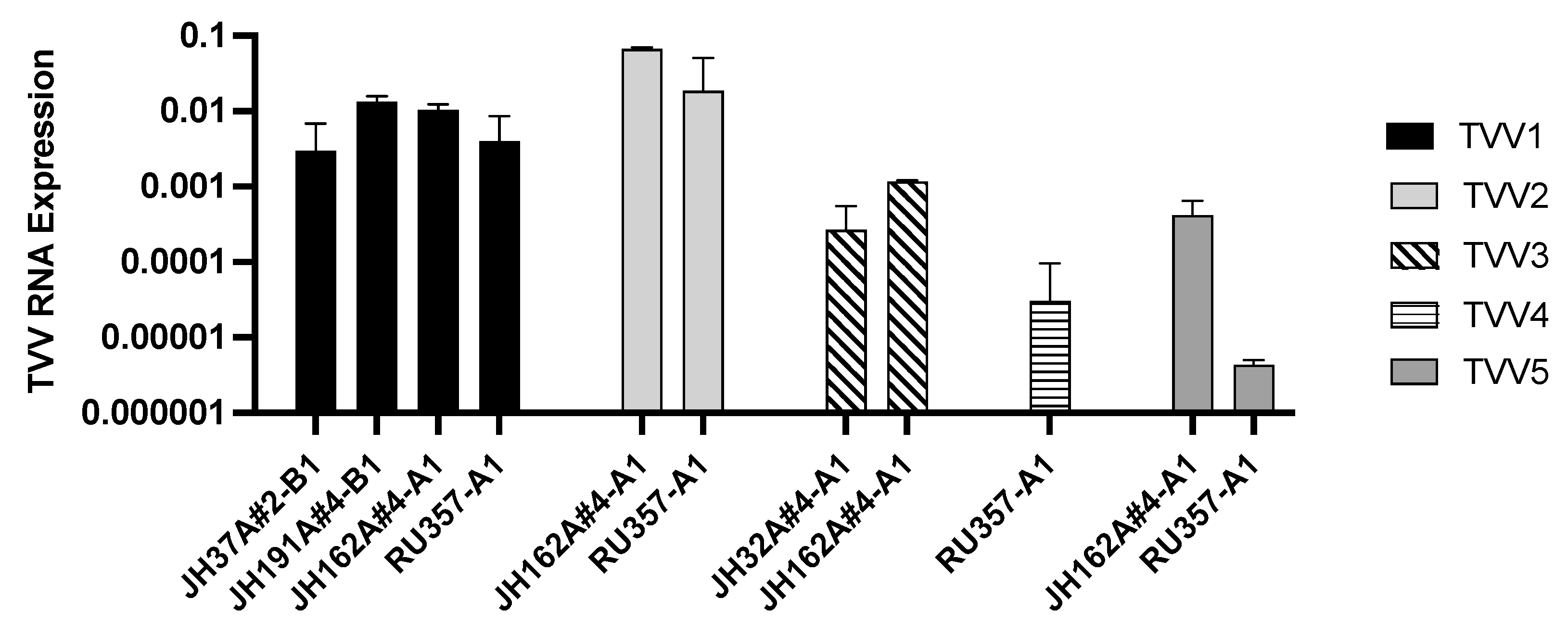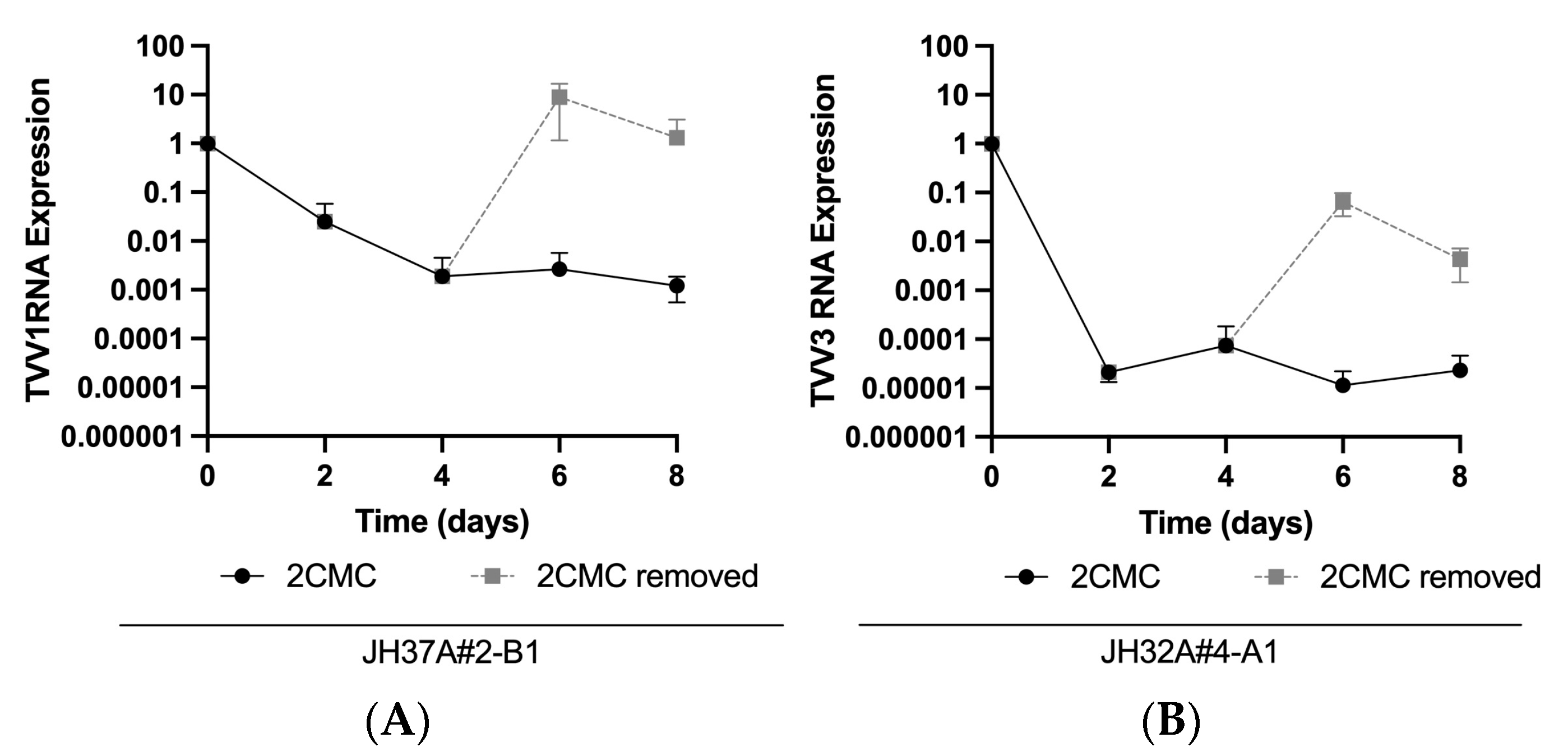Differential Drug Susceptibility across Trichomonasvirus Species Allows for Generation of Varied Isogenic Clones of Trichomonas vaginalis
Abstract
:1. Introduction
2. Materials and Methods
2.1. Tvag Isolates and Cell Culture
2.2. RNA Extraction, cDNA Synthesis, and qPCR
2.3. Drug Treatment Assays
2.4. Generation of Isogenic Clones
3. Results
3.1. Treatment with 2CMC Is Effective at Reducing RNA Expression by Strains of All Five TVV Species, but to Varying Degrees
3.2. Susceptibility to Clearance by 2CMC Varies by TVV Species
3.3. Isogenic Clones Generated after 8 Days of 2CMC Treatment
4. Discussion
Supplementary Materials
Author Contributions
Funding
Institutional Review Board Statement
Informed Consent Statement
Data Availability Statement
Conflicts of Interest
References
- Tai, J.H.; Ip, C.F. The cDNA Sequence of Trichomonas vaginalis virus-T1 double-stranded RNA. Virology 1995, 206, 773–776. [Google Scholar] [CrossRef]
- Bessarab, I.N.; Liu, H.W.; Ip, C.F.; Tai, J.H. The complete cDNA sequence of a Type II Trichomonas vaginalis virus. Virology 2000, 267, 350–359. [Google Scholar] [CrossRef] [PubMed]
- Bessarab, I.N.; Nakajima, R.; Liu, H.-W.; Tai, J.-H. Identification and characterization of a type III Trichomonas vaginalis virus in the protozoan pathogen Trichomonas vaginalis. Arch. Virol. 2011, 156, 285–294. [Google Scholar] [CrossRef] [PubMed]
- Goodman, R.P.; Freret, T.S.; Kula, T.; Geller, A.M.; Talkington, M.W.T.; Tang-Fernandez, V.; Suciu, O.; Demidenko, A.A.; Ghabrial, S.A.; Beach, D.H.; et al. Clinical isolates of Trichomonas vaginalis concurrently infected by strains of up to four trichomonasvirus species (Family Totiviridae). J. Virol. 2011, 85, 4258–4270. [Google Scholar] [CrossRef]
- Manny, A.R.; Hetzel, C.A.; Mizani, A.; Nibert, M.L. Discovery of a novel species of trichomonasvirus in the human parasite Trichomonas vaginalis using transcriptome mining. Viruses 2022, 14, 548. [Google Scholar] [CrossRef]
- Mercer, F.; Johnson, P.J. Trichomonas vaginalis: Pathogenesis, symbiont interactions, and host cell immune responses. Trends Parasitol. 2018, 34, 683–693. [Google Scholar] [CrossRef]
- World Health Organization. Trichomoniasis. Available online: https://www.who.int/news-room/fact-sheets/detail/trichomoniasis (accessed on 25 July 2024).
- Fichorova, R.N.; Lee, Y.; Yamamoto, H.S.; Takagi, Y.; Hayes, G.R.; Goodman, R.P.; Chepa-Lotrea, X.; Buck, O.R.; Murray, R.; Kula, T.; et al. Endobiont viruses sensed by the human host—Beyond conventional antiparasitic therapy. PLoS ONE 2012, 7, e48418. [Google Scholar] [CrossRef]
- Fraga, J.; Rojas, L.; Sariego, I.; Fernández-Calienes, A.; Nuñez, F.A. Species typing of Cuban Trichomonas vaginalis virus by RT-PCR, and association of TVV-2 with high parasite adhesion levels and high pathogenicity in patients. Arch. Virol. 2012, 157, 1789–1795. [Google Scholar] [CrossRef]
- Passmore, J.-A.S.; Jaspan, H.B.; Masson, L. Genital inflammation, immune activation and risk of sexual HIV acquisition. Curr. Opin. HIV AIDS 2016, 11, 156–162. [Google Scholar] [CrossRef]
- Goodman, R.P.; Ghabrial, S.A.; Fichorova, R.N.; Nibert, M.L. Trichomonasvirus: A new genus of protozoan viruses in the family Totiviridae. Arch. Virol. 2011, 156, 171–179. [Google Scholar] [CrossRef]
- Rivera, W.L.; Justo, C.A.C.; Relucio-San Diego, M.A.C.V.; Loyola, L.M. Detection and molecular characterization of double-stranded RNA viruses in Philippine Trichomonas vaginalis isolates. J. Microbiol. Immunol. Infect. 2017, 50, 669–676. [Google Scholar] [CrossRef]
- Bokharaei-Salim, F.; Esteghamati, A.; Khanaliha, K.; Esghaei, M.; Donyavi, T.; Salemi, B. The first detection of co-infection of double-stranded RNA virus 1, 2 and 3 in Iranian isolates of Trichomonas vaginalis. Iran. J. Parasitol. 2020, 15, 357–363. [Google Scholar] [CrossRef] [PubMed]
- Khoshnan, A.; Alderete, J.F. Multiple double-stranded RNA segments are associated with virus particles infecting Trichomonas vaginalis. J. Virol. 1993, 67, 6950–6955. [Google Scholar] [CrossRef] [PubMed]
- Ong, S.-C.; Cheng, W.-H.; Ku, F.-M.; Tsai, C.-Y.; Huang, P.-J.; Lee, C.-C.; Yeh, Y.-M.; Rada, P.; Hrdý, I.; Narayanasamy, R.K.; et al. Identification of endosymbiotic virus in small extracellular vesicles derived from Trichomonas vaginalis. Genes 2022, 13, 531. [Google Scholar] [CrossRef]
- Parent, K.N.; Takagi, Y.; Cardone, G.; Olson, N.H.; Ericsson, M.; Yang, M.; Lee, Y.; Asara, J.M.; Fichorova, R.N.; Baker, T.S.; et al. Structure of a protozoan virus from the human genitourinary parasite Trichomonas vaginalis. mBio 2013, 4, e00056-13. [Google Scholar] [CrossRef]
- Narayanasamy, R.K.; Rada, P.; Zdrha, A.; van Ranst, M.; Neyts, J.; Tachezy, J. Cytidine nucleoside analog is an effective antiviral drug against Trichomonasvirus. J. Microbiol. Immunol. Infect. 2021, 55, 191–198. [Google Scholar] [CrossRef]
- Fouts, A.C.; Kraus, S.J. Trichomonas vaginalis: Reevaluation of its clinical presentation and laboratory diagnosis. J. Infect. Dis. 1980, 141, 137–143. [Google Scholar] [CrossRef]
- Fürnkranz, U.; Henrich, B.; Walochnik, J. Mycoplasma hominis impacts gene expression in Trichomonas vaginalis. Parasitol. Res. 2018, 117, 841–847. [Google Scholar] [CrossRef]
- Gunderson, J.; Hinkle, G.; Leipe, D.; Morrison, H.G.; Stickel, S.K.; Odelson, D.A.; Breznak, J.A.; Nerad, T.A.; Müller, M.; Sogin, M.L. Phylogeny of trichomonads inferred from small-subunit rRNA sequences. J. Eukaryot. Microbiol. 1995, 42, 411–415. [Google Scholar] [CrossRef]
- Carlton, J.M.; Hirt, R.P.; Silva, J.C.; Delcher, A.L.; Schatz, M.; Zhao, Q.; Wortman, J.R.; Bidwell, S.L.; Alsmark, U.C.M.; Besteiro, S.; et al. Draft genome sequence of the sexually transmitted pathogen Trichomonas vaginalis. Science 2007, 315, 207–212. [Google Scholar] [CrossRef]
- Kamzeeva, P.N.; Aralov, A.V.; Alferova, V.A.; Korshun, V.A. Recent advances in molecular mechanisms of nucleoside antivirals. Curr. Issues Mol. Biol. 2023, 45, 6851–6879. [Google Scholar] [CrossRef] [PubMed]
- Jumper, J.; Evans, R.; Pritzel, A.; Green, T.; Figurnov, M.; Ronneberger, O.; Tunyasuvunakool, K.; Bates, R.; Žídek, A.; Potapenko, A.; et al. Highly accurate protein structure prediction with AlphaFold. Nature 2021, 596, 583–589. [Google Scholar] [CrossRef] [PubMed]





| Tvag Isolate | TVV1 | TVV2 | TVV3 | TVV4 | TVV5 |
|---|---|---|---|---|---|
| JH37A#2-B1 | + | - | - | - | - |
| JH191A#4-B1 | + | - | - | - | - |
| JH32A#4-A1 | - | - | + | - | - |
| JH162A#4-A1 | + | + | + | - | + |
| RU357-B1 | + | + | - | + | + |
Disclaimer/Publisher’s Note: The statements, opinions and data contained in all publications are solely those of the individual author(s) and contributor(s) and not of MDPI and/or the editor(s). MDPI and/or the editor(s) disclaim responsibility for any injury to people or property resulting from any ideas, methods, instructions or products referred to in the content. |
© 2024 by the authors. Licensee MDPI, Basel, Switzerland. This article is an open access article distributed under the terms and conditions of the Creative Commons Attribution (CC BY) license (https://creativecommons.org/licenses/by/4.0/).
Share and Cite
Hetzel, C.A.; Appah-Sampong, A.A.; Hurst-Manny, A.R.; Nibert, M.L. Differential Drug Susceptibility across Trichomonasvirus Species Allows for Generation of Varied Isogenic Clones of Trichomonas vaginalis. Pathogens 2024, 13, 733. https://doi.org/10.3390/pathogens13090733
Hetzel CA, Appah-Sampong AA, Hurst-Manny AR, Nibert ML. Differential Drug Susceptibility across Trichomonasvirus Species Allows for Generation of Varied Isogenic Clones of Trichomonas vaginalis. Pathogens. 2024; 13(9):733. https://doi.org/10.3390/pathogens13090733
Chicago/Turabian StyleHetzel, Carrie A., Akua A. Appah-Sampong, Austin R. Hurst-Manny, and Max L. Nibert. 2024. "Differential Drug Susceptibility across Trichomonasvirus Species Allows for Generation of Varied Isogenic Clones of Trichomonas vaginalis" Pathogens 13, no. 9: 733. https://doi.org/10.3390/pathogens13090733
APA StyleHetzel, C. A., Appah-Sampong, A. A., Hurst-Manny, A. R., & Nibert, M. L. (2024). Differential Drug Susceptibility across Trichomonasvirus Species Allows for Generation of Varied Isogenic Clones of Trichomonas vaginalis. Pathogens, 13(9), 733. https://doi.org/10.3390/pathogens13090733






